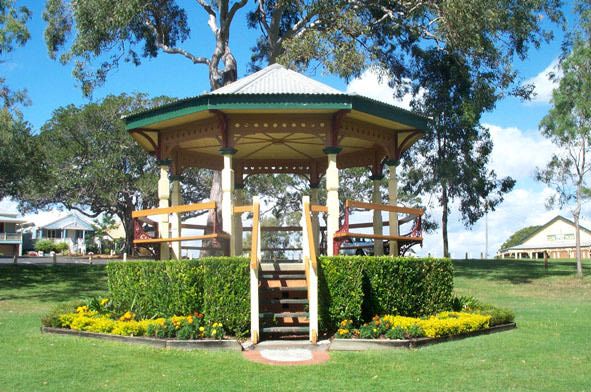Addresses
Type of place
Park, Pavilion
Period
Federation 1890-1914
Addresses
Type of place
Park, Pavilion
Period
Federation 1890-1914
Moora Park is important because it survives as a remnant of the development of the Sandgate and Shorncliffe area during the latter half of the nineteenth century. The remnant of the bandstand is highly significant as both a focal element of the Park and as a tangible element of Shorncliffe's tourist past. Moora Park is a highly scenic area of parkland, which provides elevated sea views framed by trees.
Lot plan
L1_SL5333; L2_SL5333
Key dates
Local Heritage Place Since —
Date of Citation —
Construction
Structure: TimberPeople/associations
Hubert George Thomas - The Bandstand (Architect);The Sandgate Town Council - The Bandstand (Builder)
Criterion for listing
(A) Historical; (B) Rarity; (D) Representative; (E) Aesthetic; (H) Historical associationInteractive mapping
Lot plan
L1_SL5333; L2_SL5333
Key dates
Local Heritage Place Since —
Date of Citation —
Construction
Structure: TimberPeople/associations
Hubert George Thomas - The Bandstand (Architect);The Sandgate Town Council - The Bandstand (Builder)
Criterion for listing
(A) Historical; (B) Rarity; (D) Representative; (E) Aesthetic; (H) Historical associationInteractive mapping
History
The Moora Park Band Rotunda This part of the foreshore fronting Flinders Parade was the hub of the Sandgate ‘seaside experience' from as early as the 1880s. The Sandgate Town Council erected a two-story timber combined kiosk and band rotunda in Moora Park in 1897, also approving a similar one on Flinders Parade.
The structure was designed by Brisbane architect Hubert Thomas, who shortly afterwards moved to Sandgate and designed a number of local buildings. A unique feature of the structure was the covered band rotunda. The Sandgate Town Band was formed around the same time, and performed in the rotunda on public holidays and special occasions.
In 1932 the timber kiosk was replaced with a brick and stucco structure designed by the City Architect, A. H. Foster. This was located on the embankment overlooking the Shorncliffe Pier. The new kiosk operated until the late 1960s when poor patronage forced its closure. It remained abandoned until 1974 when the Brisbane City Council had it demolished.
The band rotunda was retained when the old kiosk was demolished, and was mounted on a low brick and concrete base.
It has been restored in recent years. The rotunda remains the only remnant of Sandgate's seaside entertainment area, which at its peak, included swimming baths and an open air picture theatre.
Description
Moora Park is part of the extensive foreshore parkland that extends from Shorncliffe to Brighton. The Park occupies part of the elevated Shorncliffe bluff and enjoys extensive views across Moreton Bay and to the Redcliffe Peninsula.
The park comprises extensive lawns, shaded by large mature trees. At the southern or highest end of the site is a carpark. The site falls steeply via heavily vegetated embankments to a levelled area beside the water. Structures in the park include an 1897 bandstand, a 1990s replica bandstand, a 1970s picnic shelter and a large 1950s amenities block below the embankments at the northern end of the site. This complex serves the “bathing enclosure” formed by the Shorncliffe Pier and the breakwater to the south of the Pier.
Note: The extent of this site report does not include the foreshore components of the park (Lots 414-416 on SL 11521) and therefore excludes analysis of the breakwater and the Shorncliffe Pier.
The Bandstand
The most significant structure in the park is the remnant of an 1897 bandstand and kiosk, designed by H.G.O. Thomas. This is located in a high open area at the southern end of the park and enjoys commanding views of the sea. The bandstand itself is an important focal element in the park. Only the upper level of the original 2-storey structure survives. The octagonal pavilion now rests on a brick and concrete base, (which is largely concealed by a hedge). The ornate timber posts are encircled by a bench seat, except where a set of timber steps provides access to the concrete plinth. The bench seat is supported from the posts by elaborate cast iron brackets. The posts support a perforated ring beam, which in turn supports a corrugated iron roof.
Other structures
Picnic shelter
This flat-roofed shelter with brick semi-enclosed seating areas is located below the bandstand.
Replica bandstand
This hexagonal pavilion stands to the east of the original. With its perforated fascia and chunky seat brackets, it attempts to evoke the architecture of Thomas’ bandstand.
Amenities block
This brick, flat-roofed amenities block accommodates toilets and changing rooms.
Paths and driveways
Vehicular and pedestrian access to the foreshores is provided by a number of paths and driveways. On steeper parts of the site they are supported by stone retaining walls.
The park has evolved to reflect the decline of Shorncliffe as a bathing and scenic destination. Substantial structures such as A.H. Foster’s 1932 kiosk have gone and the Park is primarily a green, passive recreational space. However the Park contains spaces of great scenic value and its avenue of mature trees provides a shaded alternative to the foreshore path below. The Bandstand, though severely truncated, remains a valuable and scenic remnant of Shorncliffe’s past. A visual inspection of the bandstand reveals it to be in good condition.
The whole of the site is significant with the exemption of the picnic shelter, replica bandstand and amenities block.
Statement of significance
Relevant assessment criteria
This is a place of local heritage significance and meets one or more of the local heritage criteria under the Heritage planning scheme policy of the Brisbane City Plan 2014. It is significant because:
References
-
Brisbane City Council - City Assets Branch Conservation Management Study Stage 1 Report. November 2002
Citation prepared by — Brisbane City Council (page revised September 2020)
